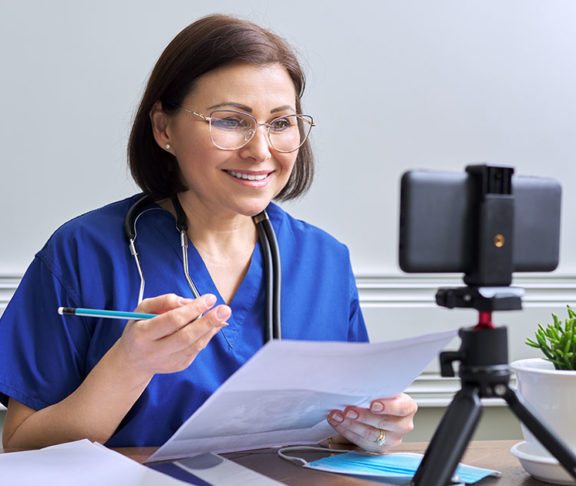The American Academy of Ambulatory Care Nursing (AAACN) defines professional telehealth nursing as a complex, multifaceted specialty that encompasses independent and collaborative practice.
The comprehensive practice of telehealth nursing is one built upon a broad knowledge base of nursing and health sciences, and applies clinical expertise rooted in the nursing process.
According to the Assistant Secretary for Planning and Evaluation (ASPE) Office of Health Policy, telehealth use increased dramatically during the COVID-19 pandemic. One 2020 study found that telehealth use peaked in March and April 2020, increasing from less than 1% of healthcare visits to aMs high as 80% of visits in places where the pandemic prevalence was high — driving telehealth utilization to record high levels.
In fact, according to an ASPE analysis of telehealth trends during the pandemic, using data from the Census Bureau’s Household Pulse Survey (HPS) of more than 800,360 adults from across all 50 states and Washington, D.C., 1 in every 4 adults reported having an appointment with a healthcare professional by video or audio — with telehealth usage particularly elevated from April to October 2021.
During the pandemic, AAACN recognized the growing urgency for telehealth care and its impact on the association’s membership. AAACN’s Kathleen Martinez, MSN, RN, CPN, began her term as AAACN’s 2021-2022 president in April 2021 – the height of telehealth usage in the United States.

Kathleen Martinez, M.S.N., RN, CPN
President, American Academy of Ambulatory Care Nursing
The pandemic brought attention the need, and importance, of telehealth care. How are today’s ambulatory nurses responding to the rise in telehealth care pathways?
Telehealth and telephone triage have always been core competencies of ambulatory care nursing. As a matter of fact, telehealth has been in existence since the invention of the telephone. Traditionally, healthcare providers traveled to people’s home to deliver care. In the same spirit, ambulatory care nurses today meet people where life is lived: in schools, community centers, clinics, and their homes. For decades, ambulatory care nurses have used telecommunication and telehealth to reach individuals in these settings.
Think about it: if you were feeling ill, had limited transportation options, or lived in a rural location, how great would it be to talk to a highly trained, experienced healthcare professional from your home? Somewhere along the way we decided that it was a good idea to insist that sick, anxious, and physically challenged individuals should travel to healthcare facilities to receive care. It certainly made it easier for the care providers, but what about the patients we have committed to serve? What about the care of the patient?
During the pandemic, ambulatory care nurses were always present and available, providing information, education, recommendations, and direction in a time of misinformation, anxiety, and fear.
Kathleen Martinez
What career opportunities and/or certification opportunities in telehealth care are there for those considering ambulatory care nursing as a career path?
Currently some ambulatory care nurses are working 100% remotely and providing telephone triage services. The options to use telehealth to promote wellness and limit illness are limitless. To name a few: primary care, palliative care, school health, pediatric and perinatal care, mental health, chronic diseases, nursing homes, childcare facilities, and all specialty care areas. The opportunities for extending care in rural communities are especially compelling. As rural areas are losing providers and critical care hospitals, individuals in these communities have access to world-class care through ambulatory care nursing-assisted telehealth visits with larger facilities.
Right now is an amazing time to launch a career in ambulatory care nursing. Although there is not a specific certification for telehealth nursing, ambulatory care nurses who provide telehealth nursing care to patients are required to possess knowledge and competencies in this area. For this reason, the Ambulatory Care Nursing Certification (RN-BC) is an excellent certification to validate expertise and is a great option for telehealth nurses. For those looking at building a career in ambulatory care nursing, telehealth nursing is exciting, challenging, and satisfying. There is no greater privilege than using our knowledge and compassion to assist another in achieving optimal health and wellness.
How did ambulatory care nurses navigate the surge to telehealth during the pandemic, and how are today’s ambulatory care nurses remaining resilient?
We have seen pain and we have endured loss. We have been tested in ways never anticipated and have responded with courage and ingenuity never imagined. During the pandemic, ambulatory care nurses were always present and available, providing information, education, recommendations, and direction in a time of misinformation, anxiety, and fear. As ambulatory care nurses, we are experts at care coordination, transition management, and telephone triage. These skills were paramount during the pandemic. While other specialties scrambled to redefine their profession within the limitations imposed by the quarantine and government regulations, ambulatory care nurses seamlessly navigated the chaos to ensure the health and safety of patients.
In the early days of the pandemic, many nurse-based telephone triage call centers saw their call volumes increase by thousands of calls per day. Nurses put in long hours and worked extra shifts while trying to sort out information and guidelines that were changing daily. Telephone triage is a complex skill where the nurse is required to assess a patient using only the phone. Many ambulatory care nurse leaders were tapped to take on unprecedented telehealth projects.
Now, as we take a breath and prepare for our next adventures in delivering patient care, today’s community of ambulatory care nurses stand resilient as an enriched and caring community who is here to encourage, support, and cheer one another on as we continue to bring care to those who need us most.

